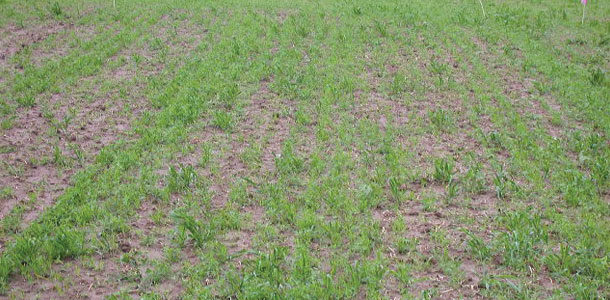Alfalfa can be seeded with conventional tillage, reduced tillage and no-till. However we seldom truly seed alfalfa no-till because we want to disc the field at least once to level it for hay making. This also gives us a chance to incorporate phosphorus fertilizer, if necessary.
Either drills or broadcast seeders (such as a Brillion seeder) can be used equally well. However, a drill tends to work better on the extreme soil conditions when soils are too wet, too hard or too loose.
The row spacing on drills can be 8 inches between rows or anything less for maximum yield once the alfalfa is established. However, wider row spacing may require more attention to weed control at early stages.
We strongly recommend using variety trial results to select varieties with high yield potential. I have run almost 300 trials over the last 30 years, and the average difference between the highest-yielding variety and lowest-yielding variety growing side-by-side in the same trial has been 2.25 tons per acre per year.
Thus, choosing a high-yielding variety can result in $450 to $650 per acre each year at little to no extra cost of production. A high-yielding variety is certainly worth whatever the seed cost.
Most of the better varieties of alfalfa are now sold with coated seed. The coatings generally include the rhizobium inoculum and a fungicide (Apron).
Some companies add other products to enhance seedling growth. The coating may be either 8 percent or 32 percent of the seed weight (you can tell by looking for the percentage of inert material on the seed tag).
Some companies use a green coating, some red – and Roundup Ready alfalfa seed, regardless of company, is coated purple.
Apron is a fungicide that inhibits growth of several seedling diseases, including pythium damping-off and phytophthora occurring in the early season.
More recently, some companies have additionally added another fungicide, Stamina, to the seed coating to help protect against seedling death from aphanomyces.
If you have this disease in your fields (as indicated by spots in alfalfa fields that are stunted and yellowish), the additional fungicide might be beneficial.
The question of seeding rate will likely be argued forever. However, a few thoughts are in order. No matter how much seed you plant, the alfalfa stand will thin to 25 to 35 plants per square foot by the end of the seeding year.
Each pound of seed per acre will result in five seeds per square foot. The general recommended seeding rate is 10 to 12 pounds per acre. This is 50 to 60 seeds per square foot.
Many farmers seed at higher rates per acre, and individuals should continue to use practices that have worked for them. Clearly, higher seeding rates will have more plants come up initially.
This can help control weeds. Additionally, there are some reports that higher seeding rates in a spring seeding will produce more yield in the first cutting of the seeding year.
While this would not have been important before, it may justify a higher seeding rate when hay is $200 to $300 per ton.
There is little data to support this at this point, but I encourage you to try a higher and lower seeding rate to see if there is a yield response in the first cutting that would justify the additional seed cost.
It does appear that Roundup Ready alfalfa can be seeded at slightly lower rates than conventional varieties since weed control at early seedling stages is improved.
Then consider that the three major reasons for failure to get an alfalfa stand are low pH (in some soils), improper seeding depth and failure to pack the soil around the seed. These are all largely preventable, and farmers getting good stands have learned how to overcome these.
First consider soil pH; it should be around 6.8 for optimum establishment of alfalfa. Soil should be tested and lime-applied if the pH is below 6.6. It generally is recommended to apply the lime to the preceding crop to give lime time to react to raise the soil pH.
Alfalfa can be seeded into soils with higher pH (up to about 8.5) with little difficulty, though nutrient needs will change slightly.
The second major reason for stand failure is not placing the alfalfa seed at the correct depth. Alfalfa seed should be placed a quarter-inch to a half-inch deep for medium to heavy soils. One can, and should, go somewhat deeper on sandy soils.
The third major reason for stand failure is lack of packing the soil around the seed. Good seed-to-soil contact is necessary so the seed can get the water it needs from the soil to germinate.
Loose soils have too much air space, and the seed will not get the moisture it needs. Loose soil at planting can often be diagnosed when stands are better in the headlands (where extra traffic occurred) or in wheel tracts.
Consider that there are multiple ways to spread the seed across the field and all will work if the seed is placed at the correct depth and soil packed around it.
Some use a seeder, some broadcast it with fertilizer, some put it in the manure spreader – as long as seed is uniformly distributed across the field, all methods are acceptable. However, after distributing the seed, one must incorporate it.
A Brillion seeder drops the seed between two corrugated rollers, which both packs the soil around the seed and incorporates seed to the shallow recommended depth.
Smooth rollers can work for packing but are not acceptable for incorporating seed distributed on the surface because they do not incorporate seed, but it is pushed into the soil surface without covering it with soil.
A cover crop can be seeded with a spring seeding – but not a fall seeding. The cover crop will slightly delay alfalfa establishment, which is OK in the spring but may result in stand failure with a fall seeding.
Cover crops may be beneficial for reducing wind or water erosion or for drawing water out of cool, wet soils. The cover crop may also increase yield of a spring seeding in the seeding year but should be removed as forage early so the crop can be sprayed for insects if necessary.
After the stand is seeded, one must pay attention to weed control for the first 60 days. Broadleaf and grassy weeds can come in to thin stands.
This can be especially crucial if weather remains cool after seeding, when weeds that grow at cooler temperatures will out-compete the alfalfa, which requires slightly warmer temperatures.
This occurred widely in 2013 where the cool early spring weather favored the weeds. Roundup Ready alfalfa was beneficial in these situations since it could be sprayed earlier than other herbicides post-emergent.
If fall planting is following a small grain, it is especially crucial to control the volunteer small grain, as each small-grain plant will leave a hole in the stand. I recommend spraying to control if as few as one small-grain plant per square foot emerges.
In summary, if one selects a good variety, applies lime to proper pH (if necessary), makes sure the seed is correctly placed and soil packed around it, and controls weeds for the first 60 days, good stands will result. FG
PHOTO
This thin new seeding shows alfalfa coming up in streaks, which is indicative of poor seeding depth control on the drill. Photo provided by Dan Undersander.

Dan Undersander
Extension and Forage Agronomist
University of Wisconsin












